Go Back to current Column
A Violin Ready for Its Close-up
Using studio portrait techniques for drama, impact
By Frank Van Riper
Photography Columnist
If you are lucky, a bargain that seems too good to be true (or at least does not wind up costing you twice what you thought it would) sometimes turns out to be, if not an actual bargain, then at least the answer to a prayer.
That was the happy outcome for Laurent Weibel, who at 35 is one of the youngest members of the famed National Symphony Orchestra in Washington, DC. Laurent plays second violin for the NSO, and started playing with the orchestra in 2001. He is a native of Lyon, France, and studied at the Paris Conservatory. He was a Fulbright Scholar at the Manhattan School of Music and completed his doctorate at the State University of New York at Stony Brook.
Recently, Laurent hired us to make documentary close-ups of what turned out to be the violin of his dreams. The photos could have been made outdoors, by available light and with the violin propped up against a chair. But this was our friend, the violin was stunning—and if a job is worth doing, it’s worth doing right. This is the story of that photo shoot.

Detail shot of the “scroll” on NSO violinist Laurent Weibel’s 1947 Bellafontana violin. Lighting was set up to “blow out” the background and make the instrument stand out. All photos © Goodman/Van Riper Photography.
My wife Judy and I first met Laurent through our web designer, Flo Altenburger, herself a concert violinist (and obviously a multi-tasker) who has added to her achievements the recent birth of her beautiful daughter Louise.
If you think the professional photography community in a city like DC is small, think how small must be the universe of classical musicians who play for major symphonies and orchestras. (Flo plays for the Baltimore Opera when she is not tending to Louise or designing websites.)
The bottom line is that everyone in the field knows everyone else, so it was not unusual for Flo to let Laurent use her own very valuable violin for two years while Laurent searched for a new instrument.
“I tried violins for a long time,” Laurent noted recently in an e-mail. “You may remember I was playing on Flo's violin for 2 yrs....
“I tried a number of Vuillaumes (famous 19th century French maker) and many modern Italians, but they either sounded too bright or too mellow....it's hard to find instruments with a tone that's both powerful and rich....most of the time, the tone is bright [and] powerful but also [is] aggressive with not much depth, or it's warmer, richer but the instrument doesn't project.”
Ultimately, Laurent found what was described as a 60-year-old Bellafontana violin, made in Genoa. The Bellafontana “seemed to have both power and warmth, which struck me right away,” Laurent said. “I wanted to make sure it was original, that's why I needed the pictures to send to a specialist in Cremona [Italy]. I took the violin to a few dealers in DC and NY but they wouldn't give me a definitive answer. One dealer said I should send pictures to Italy.”
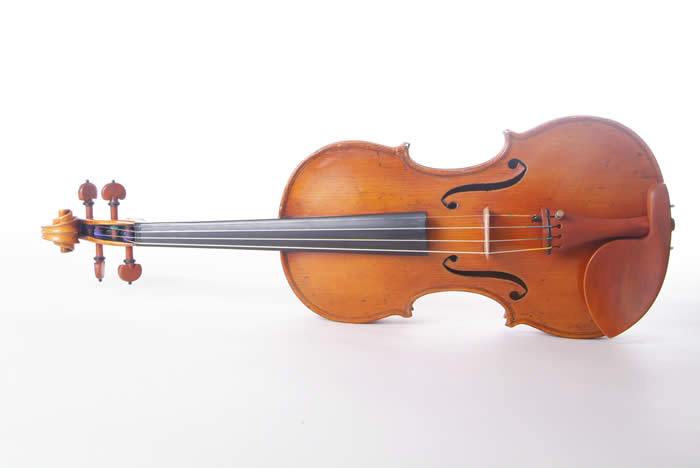
Full-length portrait of the Bellafontana. Since I did not want to clamp or otherwise touch the instrument to hold it upright, I simply laid it down on the seamless. Telltale shadows at bottom indicate the horizontal position, but rendering of violin is the same.
Enter Goodman/Van Riper Photography. We have done our share of product shots in the past—for annual reports and brochures—but in this case, with so beautiful an instrument, we also wanted the photos to be more like portraits to show the Bellafontana at its best while also revealing as much detail as possible.
That’s why I chose to photograph the violin in the studio, not only against a plain light background, but also to set the lighting so that the background actually would “disappear” and leave only the violin in the frame. This is a common practice for magazine covers where the art director needs the background to “blow out” and thereby leave plenty of shadowless white space for text and headlines directing the reader to what’s inside. It’s also a common technique for many fashion photos.
Though the effect looks dramatic, the setup actually is fairly simple. The rule of thumb is to set your lighting so that the two lights illuminating the background are equidistant, and, most important, so that they are at least two f-stops brighter than the working exposure for the subject—in this case Laurent’s violin.
I set up a light seamless background in our home/studio in upper northwest Washington and, using light stands, first positioned two old White Lightning 10,000 flash units on either side of the paper. (Note: White Lightnings are rugged American-made studio strobes, manufactured by Paul C. Buff in Nashville, TN. I have used a slew of these and other White Lightnings for two decades, on all kinds of jobs, from on-location album covers to elaborate studio shoots. The units I was using here to light the background were two of my oldest WL’s, often dubbed “coffee cans” for their clunky appearance.)
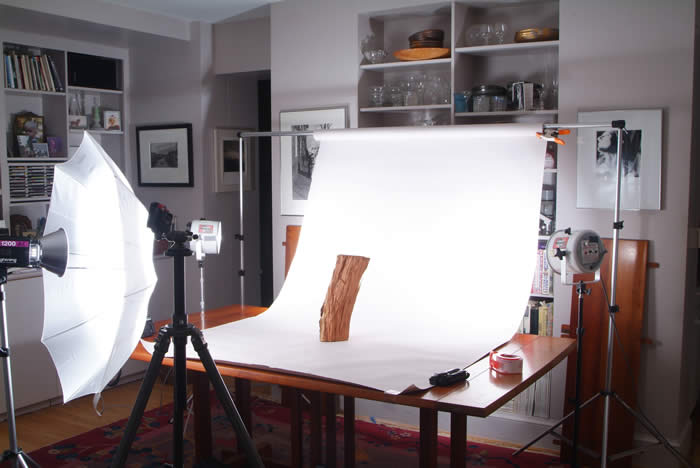
Practice shot to check lighting setup. Note two “coffee can” White Lightning strobes close to seamless to light it brightly. Shoot-through umbrella strobe lights subject, in this case a humble fireplace log.
To light the violin, however, I wanted more than harsh, direct light. I literally wanted a soft portrait light that would rake across the violin’s surface, showing detail, but also minimizing glare off the instrument’s shiny surface. A shoot-through umbrella was the perfect solution.
Shoot-throughs often wind up as the easy alternative to larger and frankly more cumbersome softboxes. Both operate on the principal of diffusing direct light through translucent white fabric. Note: photo umbrellas often are used in the opposite mode: bouncing indirect light back onto a subject . In this case, however, I wanted the light to be more direct and as close to my subject as possible for maximum softness.
I positioned a powerful White Lightning Ultra on a light stand, then placed a translucent umbrella on the strobe. To make it a “shoot-through” I simply angled the strobe so that it would “shoot-through” the umbrella into my subject.
[One funny note on the set-up. Before Laurent arrived for the shoot with his Bellafontana, I wanted to make at least a few preliminary shots to test the lighting. But what did I have that mimicked the size and shape of a violin? Not much, it turned out. But I did grab a log of firewood from the porch and, sure enough, I achieved the effect I was after: a blown-out background and soft directional lighting on the subject.]

I call this: “Portrait of Firewood.”
When Laurent arrived, Judy and I ooh’d and aah’d over the violin, then set to work. Since Laurent was after detail shots—to show the expert in Cremona—we decided to have Laurent handle the instrument throughout the shoot—and not try to prop it up from behind or, heaven forbid, secure the violin with gaffer’s tape or clamps—two common studio tools.
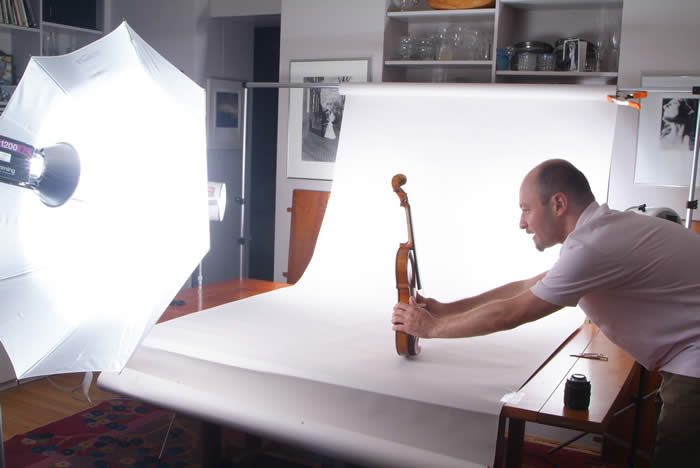
I call this: “High-Priced Assistant with Even Higher-Priced Subject.”
The shoot went off flawlessly and the pictures turned out beautifully. I used a 60mm Nikkor macro lens on my Fuji Finepix S3 digital camera. The only fine-tuning of the main light came when I angled it a little bit more obliquely to minimize glare.
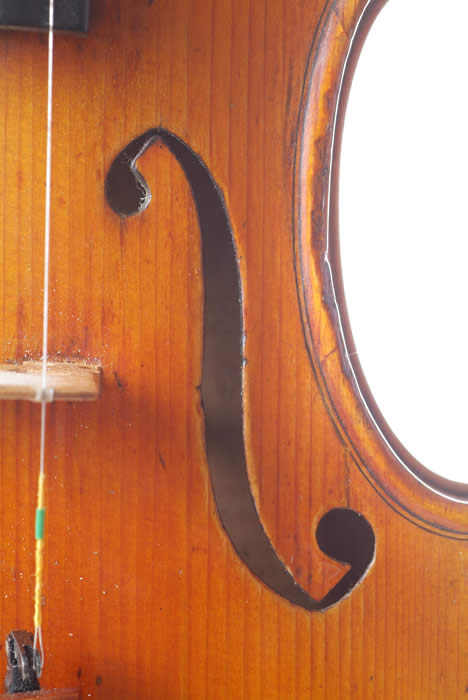
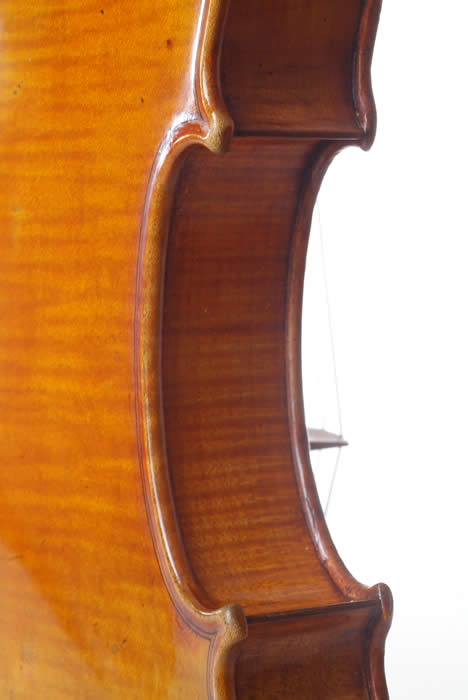
Detail shots, like these of the violin’s f-hole and side, can provide key clues when seeking an instrument’s provenance
Laurent loved the shots and promptly FedEx’d the CD of images to Cremona, confident that the expert there would confirm what he knew in his heart: that this was, in fact, a 1947 Bellafontana, and, more important, that this was to be his next (and best) violin.
“I waited for the specialist to reply for two weeks,” Laurent said. “I e-mailed, called, but still [hadn’t] heard anything. Meanwhile the seller was pressing me for an answer and I finally decided to buy it, despite not being 100% sure it's an original Bellafontana, because I fell in love with it, tried it in orchestra, chamber music, solo. I had many colleagues try it, etc., and it proved to be excellent in all configurations.”
There are times when one’s heart (as well as one’s long experience as a musician) must outweigh technicalities. And after the shoot, when Laurent played it briefly for us to share a sound that was as sensual as it was powerful, Judy and I had no doubts that Laurent had made the right choice. Here was an instrument as precious to Laurent as my Leicas are to me. He had to have it—and he did.
And for how much?
$45,000.
“Yes,” Laurent said, when I asked, “you can mention the price, which was a factor too. Everything I had tried was at least twice at much.”
And, he might have added, sounded half as good.
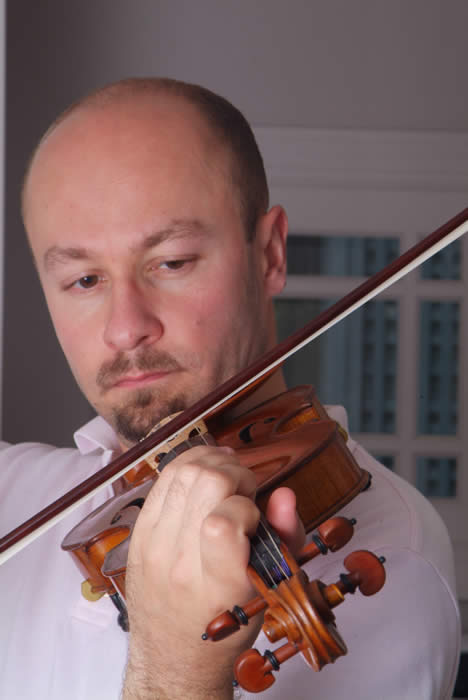
NSO violinist Laurent Weibel playing his cherished 1947 Bellafontana violin.
Frank Van Riper is Washington-based commercial and documentary photographer, journalist and author. He served for 20 years in the New York Daily News Washington Bureau as White House correspondent, national political correspondent and Washington bureau news editor, and was a 1979 Nieman Fellow at Harvard. Among others, he is the author of the biography Glenn: The Astronaut Who Would Be President, as well as the photography books Faces of the Eastern Shore and Down East Maine/A World Apart. His book Talking Photography is a collection of his Washington Post and other photography writing over the past decade. He can be reached through his website www.GVRphoto.com
[Copyright Frank Van Riper. All Rights Reserved.]
|